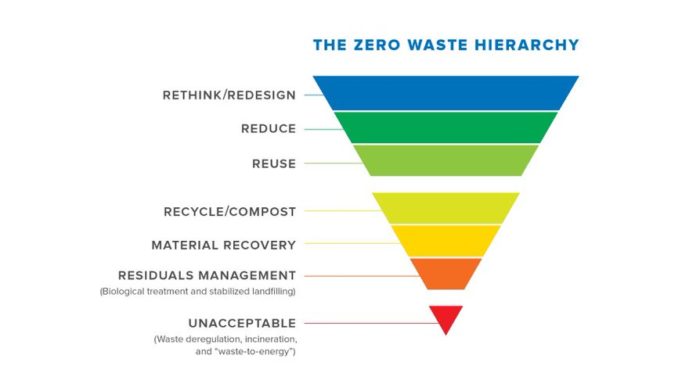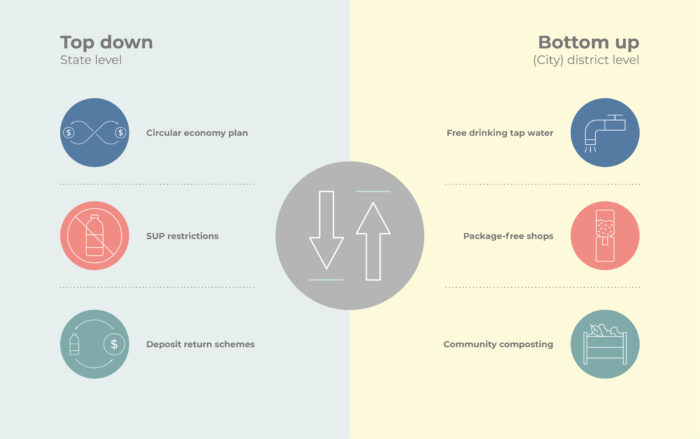What is zero waste?
The official Zero Waste definition, adopted by Zero Waste International Alliance:
Zero Waste: The conservation of all resources by means of responsible production, consumption, reuse, and recovery of products, packaging, and materials without burning and with no discharges to land, water, or air that threaten the environment or human health.
“Zero Waste” is increasingly being adopted as a “toolkit” to turn the Circular Economy vision into practice. Even the first Circular Economy Package proposed by the EU in July 2014, was sub-titled “A Zero Waste Programme for Europe”.
The guiding principle of Zero Waste (ZW) is the commitment to constantly:
- improve the management of resources,
- reduce progressively the amount of waste,
- increase the percentage which is reused/recycled/composted,
- assess what is not recovered in order to have it redesigned.
This approach connects with the 4 R’s strategy, and has already proved to be a powerful driver to minimise leakages of resources from their circular use.
Sometimes the term “Zero Waste” is misused, either
-
in a simplified way (“no production of waste”, and “no need to have waste processing sites, whatever their nature”, which doesn’t show the need to manage reusable materials and reprocess recyclable and compostable waste), or
-
including technologies and processes (e.g. incineration, pyrolysis or other types of thermal treatments) that do not belong in the ZW path. They destroy resources and require a long-term fixed amount of materials to burn (in other words – more waste is constantly needed) and this is in contradiction with the principle of improving recycling rates and minimising residual waste.
Actually, ZW has been formally adopted as a guiding waste management strategy by a growing number of municipalities and communities all over the world. Typically, ZW schemes include the following key points (sometimes in different order and combination):
- Avoid waste by reuse, repair and de-construction.
- Encourage waste reduction initiatives.
- Sort at source wherever waste is produced.
- Collect sorted waste separately.
- Compost organic waste.
- Recycle all materials.
- Study residual waste to find better options for material separation and redesign.
- See landfilling as a temporary solution, with decreasing amounts. Minimise impacts through pre-treatment.
- Apply industrial design and help to change consumer behaviour.
- Use economic incentives to encourage all of it!
The Zero Waste International Alliance (ZWIA) has framed an “operational roadmap” – the “Zero Waste Hierarchy of Highest and Best Use” (meaning the cascading approach) showing all options to retain resources in their highest status, what to do with residual waste (mixed garbage) and what is not acceptable in the ZW approach.
The following chart visualises the hierarchy as a “funnel”, progressively minimising what is left for disposal (“residuals management”) and leaves out what is deemed “unacceptable”.

Zero waste principles in policy
By its nature, ZW is a process that can be put into practice at local level, by communities (villages, municipalities, neighbourhoods, etc.). Local implementation is what “makes it happen”, and shows the way to other communities to follow. However, local initiatives can benefit from a good regulatory framework and ZW-oriented “top-down” policy. This can frame the steps towards ZW, provide for economic incentives, define clear conditions for markets for recycled materials, and/or provide the legal basis for bans and restrictions.
While community-based ZW initiatives “make it happen”, ZW-oriented policies “make it possible”; good interaction between the two is the best way to have fast and successful implementation of the ZW approach.

Some examples of ZW-oriented policy:
- EU Circular Economy Package, originally sub-titled “a Zero Waste Programme for Europe”, borrows many of the ZW guiding principles:
- emphasis on ecodesign and redesigning for durability;
- increasing the targets for recycling and composting (a recycling target of 65% of actually recovered materials, minus the materials rejected from recycling/composting processes, by 2035),
- the need to avoid any “lock-in” effect potentially caused by investments in technologies (as incineration and other thermal treatment options) requiring a secured tonnage of mixed waste to be financially viable. For more info on the topic, read the “Communication on the role of Waste-to-energy in the Circular Economy” by European Commission.
- Bans and restrictions may play a major role in a Circular Economy and ZW programmes, and promote innovation and new business models. An increasing number of countries (or jurisdictional sub-divisions, e.g. states in the US, cities in Germany, etc.) have or are planning to ban or tax one or more of the following:
- plastic bags (e.g. Italy, France, California, Kenya),
- cotton buds (e.g. United Kingdom, Italy),
- single-use plastic cutlery and coffee pods (e.g. France, Hamburg),
- all single-use plastics (e.g. India, Costa Rica).
More similar examples can be found here. In 2019 European Union released it’s Single Use Plastics Directive, which gives basis to restrict, ban or reduce the use of several single use items across the 27 Member States.
- Economic tools may be a great way to move progressively away from wasteful behaviours and purchasing habits, and drive innovation:
- Extended Producer Responsibility (EPR) can be adopted to have separate collection and recycling schemes funded by packaging producers (EPR schemes collect unit fees from producers, then the budget is allocated to compensate municipalities for the cost of separate collection, and/or to support/reward recycling activities). EPR has long been adopted in Europe for packaging waste, electric/electronic waste, and other types of goods and materials. Also important: EPR schemes should not be designed to kill local recycling initiatives, but to support them – EPR schemes must simply fund the system, not run the business.
- Deposit-Refunding Schemes (DRS) have proved to be the most effective way to have a high return rate of specific items: customers return the item (e.g. beverage bottles and cans) to the shop where purchased or (more commonly) any cooperating shop, to get the deposit back. This maximises collection rates of items within the DRS, boosts their reuse or recycling, and minimises littering of those items. Well-working DRS systems have been adopted for various containers by Denmark, Estonia, Germany, single states in the US, parts of Australia, etc. Good overview of all the countries can be seen here.
